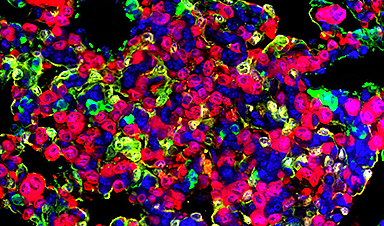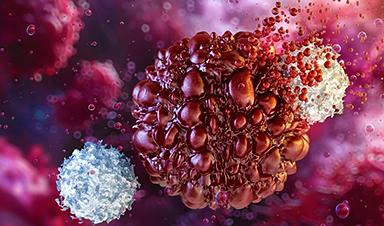A new understanding of lung cancer cells’ “memories” suggests a new strategy for improving treatment, Memorial Sloan Kettering Cancer Center (MSK) researchers have found.
The study looked specifically at lung adenocarcinoma, a type of non-small cell lung cancer that is the most common type of lung cancer in the U.S. and responsible for 7% of all cancer deaths. This cancer is frequently driven by mutations in the KRAS gene.
“For a long time, cancer-driving KRAS proteins were considered ‘undruggable,'” says study co-first author Zhuxuan “Zoe” Li, a doctoral student in the Tammela Lab at MSK’s Sloan Kettering Institute. “Within the last few years, however, the U.S. Food and Drug Administration approved the first KRAS inhibitors, with quite a few more in clinical trials. But they don’t work for everyone, and most patients’ cancers eventually acquire resistance to the drugs and come back.”
The team’s findings—co-led by postdoctoral fellow Xueqian Zhuang, Ph.D.—shed important light on lung cancer cells that linger after treatment with a KRAS inhibitor. Importantly, they suggest that separately targeting these cells alongside treatment with a KRAS inhibitor could help prevent recurrence. The study was recently published in Cancer Discovery, a leading journal for biological insights that have important implications for clinical care.
Stem cells with a day job
To understand the MSK discovery and its implications, it’s helpful to know a little about lung biology.
Within the lungs, oxygen is absorbed and carbon dioxide is released via air sacs called alveoli. The lining of the alveoli is made of two distinct types of cells—alveolar type 1 (AT1) and alveolar type 2 (AT2).
And while they’re similarly named, these two cells couldn’t be more different.
AT1 cells are long and thin, with a large surface to facilitate gas exchange between the lungs and the bloodstream.
AT2 cells, meanwhile, play a caretaking role, secreting compounds that are important for the health and function of the lungs, as well as helping maintain and repair the lungs by dividing to create replacement AT1 cells.
“You can think of them as stem cells with a day job,” Dr. Tammela says.
The big problem comes when lung cancer cells—which typically develop from AT2 cells—take on some “remembered” properties of the AT1 cells that AT2 cells differentiate into when they’re playing their stem cell role. Scientists call these cancer cells “AT1-like” cells.
Eliminating AT1-like cells improves response to KRAS inhibition
In healthy cells, KRAS plays a key role in regulating cell growth and division. But when the gene becomes mutated, it can lead to runaway cell proliferation.
KRAS inhibitors can switch off this explosive growth, greatly diminishing tumors, but they still leave behind pockets of cancer cells that aren’t sensitive to the drug, and that also gives the cancer a chance to develop new mutations to resist the drugs’ effects.
The research team painstakingly studied these residual cancer cells to uncover the mechanisms of this resistance using genetically engineered mouse models, mice implanted with patient-derived tumors, and tumor samples from patients.
They discovered that the cancer cells that remained after treatment were these AT1-like cells. They also found these cells have the capacity to reignite the cancer’s runaway growth.
“Importantly, we found that if you get rid of these AT1-like cells, it greatly improves the treatment response to KRAS inhibitors,” Dr. Tammela says.
Eliminating those cells in experimental models is relatively easy, but doing so in the clinic will require further research.
“We actually live in a very exciting time with fantastic pharmacology,” Dr. Tammela says. “We can engineer molecules to bind to a certain cell type and kill them—this is how CAR T cell therapy and antibody drug conjugates work.
“Now that we’ve done these proof-of-concept experiments, the next step would be to find surface proteins that are unique to these AT1-like cells and then develop a therapeutic that can bind to them and kill them,” he adds.
Only at a place like MSK
Collaborations with other labs were essential to the research, Dr. Tammela says.
“This is the type of research that can really only happen at a place like MSK,” he says. “We had really important collaborations with other labs at MSK that shared animal models and patient samples that were integral to the study, and we worked closely with several of MSK’s core facilities—the Antitumor Assessment Core, Integrated Genomics Operation, Flow Cytometry Core, and Molecular Cytology Core.”
MSK investigators Scott Lowe, Ph.D. and Charles Rudin, MD, Ph.D. were key contributors, Dr. Tammela notes.
“And the study would not have been possible without Zoe’s dedication, and the model systems and initial insights developed by Dr. Zhuang,” he adds.
Additional authors include Chun-Hao Pan, Yan Yan, Rohit Thummalapalli, Stefan Torborg, Anupriya Singhal, Jason Chang, and Rona Yaeger of MSK; Simon Joost, formerly of MSK and now at GC Therapeutics; Eusebio Manchado, formerly of MSK, now at the Novartis Institute for Biomedical Research; Jill Hallin and James Christensen of Mirati Theraputics; and Lukas Dow of Weill Cornell Medicine.
More information: Zhuxuan Li et al, Alveolar differentiation drives resistance to KRAS inhibition in lung adenocarcinoma, Cancer Discovery (2023). DOI: 10.1158/2159-8290.CD-23-0289
News
Researchers propose five key questions for effective adoption of AI in clinical practice
While Artificial Intelligence (AI) can be a powerful tool that physicians can use to help diagnose their patients and has great potential to improve accuracy, efficiency and patient safety, it has its drawbacks. It [...]
Advancements and clinical translation of intelligent nanodrugs for breast cancer treatment
A comprehensive review in "Biofunct. Mater." meticulously details the most recent advancements and clinical translation of intelligent nanodrugs for breast cancer treatment. This paper presents an exhaustive overview of subtype-specific nanostrategies, the clinical benefits [...]
It’s Not “All in Your Head”: Scientists Develop Revolutionary Blood Test for Chronic Fatigue Syndrome
A 96% accurate blood test for ME/CFS could transform diagnosis and pave the way for future long COVID detection. Researchers from the University of East Anglia and Oxford Biodynamics have created a highly accurate [...]
How Far Can the Body Go? Scientists Find the Ultimate Limit of Human Endurance
Even the most elite endurance athletes can’t outrun biology. A new study finds that humans hit a metabolic ceiling at about 2.5 times their resting energy burn. When ultra-runners take on races that last [...]
World’s Rivers “Overdosing” on Human Antibiotics, Study Finds
Researchers estimate that approximately 8,500 tons of antibiotics enter river systems each year after passing through the human body and wastewater treatment processes. Rivers spanning millions of kilometers across the globe are contaminated with [...]
Yale Scientists Solve a Century-Old Brain Wave Mystery
Yale scientists traced gamma brain waves to thalamus-cortex interactions. The discovery could reveal how brain rhythms shape perception and disease. For more than a century, scientists have observed rhythmic waves of synchronized neuronal activity [...]
Can introducing peanuts early prevent allergies? Real-world data confirms it helps
New evidence from a large U.S. primary care network shows that early peanut introduction, endorsed in 2015 and 2017 guidelines, was followed by a marked decline in clinician-diagnosed peanut and overall food allergies among [...]
Nanoparticle blueprints reveal path to smarter medicines
Lipid nanoparticles (LNPs) are the delivery vehicles of modern medicine, carrying cancer drugs, gene therapies and vaccines into cells. Until recently, many scientists assumed that all LNPs followed more or less the same blueprint, [...]
How nanomedicine and AI are teaming up to tackle neurodegenerative diseases
When I first realized the scale of the challenge posed by neurodegenerative diseases, such as Alzheimer's, Parkinson's disease and amyotrophic lateral sclerosis (ALS), I felt simultaneously humbled and motivated. These disorders are not caused [...]
Self-Organizing Light Could Transform Computing and Communications
USC engineers have demonstrated a new kind of optical device that lets light organize its own route using the principles of thermodynamics. Instead of relying on switches or digital control, the light finds its own [...]
Groundbreaking New Way of Measuring Blood Pressure Could Save Thousands of Lives
A new method that improves the accuracy of interpreting blood pressure measurements taken at the ankle could be vital for individuals who are unable to have their blood pressure measured on the arm. A newly developed [...]
Scientist tackles key roadblock for AI in drug discovery
The drug development pipeline is a costly and lengthy process. Identifying high-quality "hit" compounds—those with high potency, selectivity, and favorable metabolic properties—at the earliest stages is important for reducing cost and accelerating the path [...]
Nanoplastics with environmental coatings can sneak past the skin’s defenses
Plastic is ubiquitous in the modern world, and it's notorious for taking a long time to completely break down in the environment - if it ever does. But even without breaking down completely, plastic [...]
Chernobyl scientists discover black fungus feeding on deadly radiation
It looks pretty sinister, but it might actually be incredibly helpful When reactor number four in Chernobyl exploded, it triggered the worst nuclear disaster in history, one which the surrounding area still has not [...]
Long COVID Is Taking A Silent Toll On Mental Health, Here’s What Experts Say
Months after recovering from COVID-19, many people continue to feel unwell. They speak of exhaustion that doesn’t fade, difficulty breathing, or an unsettling mental haze. What’s becoming increasingly clear is that recovery from the [...]
Study Delivers Cancer Drugs Directly to the Tumor Nucleus
A new peptide-based nanotube treatment sneaks chemo into drug-resistant cancer cells, providing a unique workaround to one of oncology’s toughest hurdles. CiQUS researchers have developed a novel molecular strategy that allows a chemotherapy drug to [...]





















